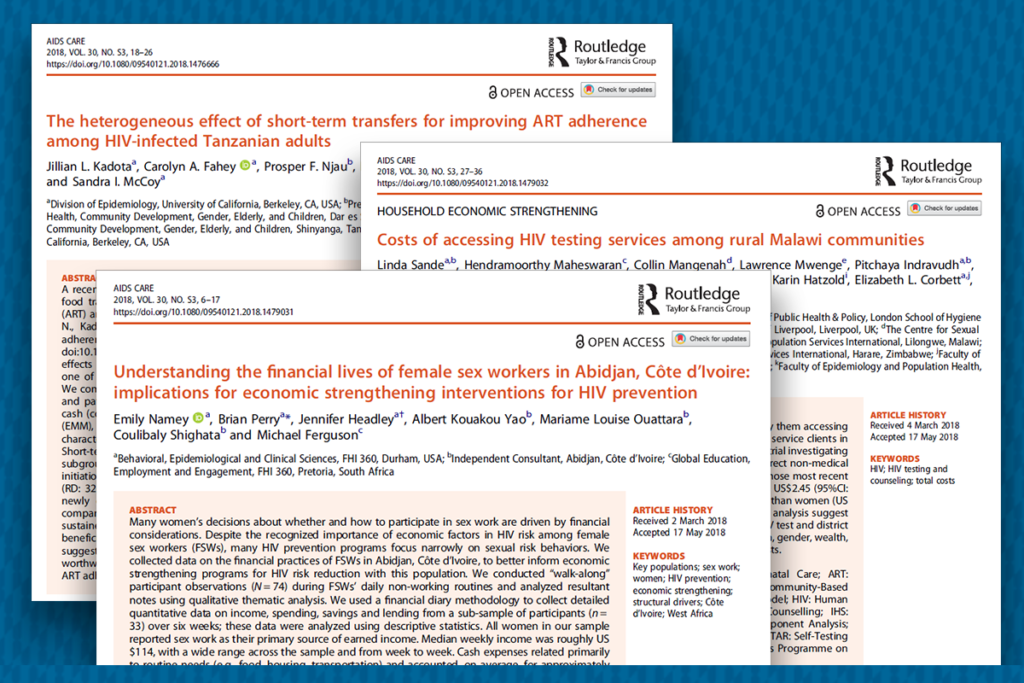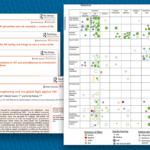Over the last three decades, a range of biomedical and behavioral approaches have dramatically reduced HIV incidence throughout the world and improved the quality and availability of life-saving treatment for those living with HIV. Yet HIV remains a major public health issue and the leading cause of adult death in sub-Saharan Africa. The most recent UNAIDS Global Progress Report issues a stark warning that with the current pace of progress we will fall far short of the 2020 global targets.
Economics and HIV risk among sex workers
Financial hardship is a major driver of women’s entrance into sex work and of increased sexual risk behaviors among female sex workers (Scorgie, et al., 2012) yet many HIV prevention programs take a narrow focus that does not address this underlying factor. In the first article, “Understanding the financial lives of female sex workers in Abidjan, Côte d’Ivoire: Implications for economic strengthening interventions for HIV prevention,” Namey, et al. used qualitative observation through two-hour “walk-along” narratives with 74 female sex workers during their daily, non-working routines. A subset of 33 women also participated in six weeks of financial diaries, a quantitative method that tracked, in detail, their earning, spending, borrowing and saving patterns. The researchers conducted a thematic analysis of the walk-along data and used descriptive statistics to summarize the financial diary data.
These kinds of economic interventions build financial stability (Carmichael and Rutherford, 2015; Gash and Odell, 2013) which the authors hypothesize could support sex workers to reduce financially-driven sexual risk-taking such as unprotected sex, anal sex or taking on more clients. The authors also point to entrepreneurship or business skills training as interventions that could help female sex workers invest in income generating activities to replace or supplement sex work, thereby further lowering their HIV risk.
The hidden costs of HIV testing
In the second article, “Costs of accessing HIV testing services among rural Malawi communities,” Sande, et al. used a retrospective design to explore and document the costs people incurred to access an HIV test. A randomly selected subset of households involved in a cluster-randomized controlled trial took part in an extended household survey at baseline. Participants who had tested for HIV in the last 12 months (n = 749) answered questions about their most recent testing experience, including the location of the test, time it took to travel to the testing site and receive testing, if their test was conducted in conjunction with receiving other health services or separately, and the direct non-medical and indirect costs they incurred.
While HIV testing is free in Malawi, the authors find that people face a number of costs, including transportation, food and child care, among others. By far though, the main cost is indirect: lost income from the time taken away from work or a business to travel to and wait at the testing site (around three hours in total for participants in this study). For that reason, men, whose earning potential is greater, incurred a significantly higher cost when testing (3.81 USD) compared to women (1.83 USD). The authors postulate that this may contribute to lower testing uptake among men in many sub-Saharan African contexts.
The authors conclude that, in a country like Malawi where 71 percent of people live below the international poverty line of 1.90 USD a day, these costs are likely prohibitive for a large proportion of the population. They point to the potential of interventions that deliver discrete testing-related financial incentives as a way to increase testing uptake, particularly among rural populations. Delivering HIV testing closer to people’s homes or at more convenient times may also mitigate these financial barriers.
Alleviating the economic burden of ART adherence
Growing evidence suggests that interventions such as food support and cash transfers can promote engagement in care for people living with HIV and adherence to ART regimens (Swann, 2018). A recent randomized controlled trial (McCoy, 2017) in Shinyanga, Tanzania, finds just that, and a secondary analysis of the study data published by Kadota, et al. in the supplemental issue sets out to identify differential effects of these interventions in various study subgroups.
The authors define a significance level of 0.2 (versus the more traditional and rigorous level of 0.05) in order to identify potential effect modifiers that warrant further exploration. Using this threshold, the study finds that food/cash transfers are more effective at increasing ART medication pick-up in the poorest patients compared to wealthier ones. Similarly, the interventions are more effective at increasing medication pick-up among people diagnosed less than 90 days prior to starting ART compared with those diagnosed 90 or more days before starting ART. The results lend weight to some intuitive ideas: 1) giving economic support to poorer people is more effective at increasing medication pick-up than economic support to wealthier people, and 2) there may be a window of opportunity following an HIV diagnosis in which interventions such as food or cash transfers can support the adoption of better adherence practices. Again, using a 0.2 threshold for significance, the study finds no evidence that the effectiveness of cash and food transfers is influenced by age or sex. There is also no evidence of differential loss to follow-up based on any of the potential effect modifiers assessed.



